WHAT'S NEW:
Eruption Confirmed!
New lava (rumbleometer stuck in flow) SE rift zone
(posted 9/1/98)
BACKGROUND:
Technology (ROV, ships, etc.)
Other 1998 Axial cruise reports
EXPEDITION:
Science Objectives
Calendar
Today's Science News
Participant Perspective
Teacher Logbook
EDUCATION:
Curriculum
Teacher Observations
Questions/Answers from sea
MULTIMEDIA:
(video clips, animations, sounds)
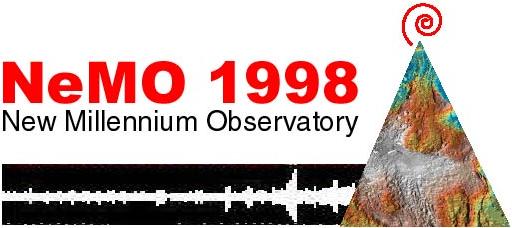
Logbook
September 5, 1998
September 5, 1998
See
Highlights Section for the Chief Scientist's Weekly Report
(Includes the ROPOS video clip)
Contents:
Special Thank-You to the Air Force!
Science Report
Daily Science Report - Sep 5
ship's location = 46 01.2N/130 01.5W
ROPOS dive 466 to the
ASHES vent field lasted 18 hours and successfully
collected
water samples and coordinated biological samples and chemical scans with the
SUAVE
chemical analyzer. One small bush of tubeworms that measured about a foot
across was
estimated to contain over 150,000 individual animals from at least 25 species,
including
the tubeworms themselves and smaller animals that live among the tubeworms, such
as
palm worms, limpets, snails, copepods, ostracods, and scaleworms. After the
dive,
more CTD's and rockcores were collected.
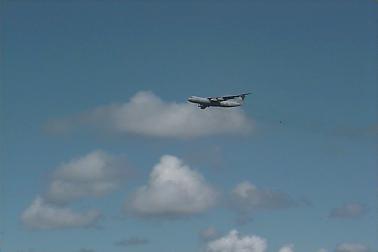
The highlight of the day was an airdrop delivery at mid-day by a C-141 airplane from McChord Air Force Base in Tacoma, Washington. The item delivered was a key component to VENTS fluid sampler (see photos below in the Teacher's log) which had failed during the first few days of the cruise before it could even be used. Since these fluids samples are such an important part of the story we are investigating, the Air Force was willing to help us out and use the opportunity as a training mission. Many thanks to them!
Early this morning ROPOS descended for dive 467, this time on the north rift zone of Axial to recover an array of instruments that had been deployed on the bottom for 2 years. The instruments are called "acoustic extensometers" and are designed to measure seafloor spreading. We found all the instruments and will recover them with an "elevator mooring" either today or in a few days, depending on the weather. We will then download the data from the instruments, replace the batteries and re-deploy them again on a later dive. We're also collecting Imagenex sonar data at the site and hope to visit a known vent site later in the dive.
Listing of all Science News postings
Life at Sea: Participant Perspective
Matthew Ofsthus
Chief Boatswain, RON BROWN

|
Chief Boatswain, Matt Ofsthus, with the package dropped by the Air Force |
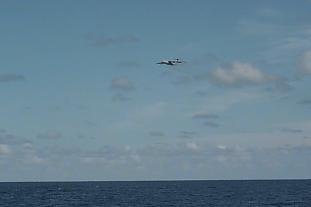
Today was a good day to write about because at about 1 pm we had a little visitor, well maybe not so little. We had a special delivery from the Air Force. Dave Butterfield was in need of a critical piece of electronics for the instrument he is using, so a call was placed to the beach a few days ago trying to find someone who would make a little detour to the ship, well it turns out the Air Force came through, dropping by parachute, the part that was critical to make Dave's equipment work.
Some of the instruments I have seen to support Vents have been interesting to say the least. That is why I enjoy the Vents Program the most of any projects I have worked with. There is always something different. The most interesting would be the ROPOS sub and the "cage" that holds it. Imagine something that is tall as a single story house, is as wide as a car, and weighs as much as four 1965 Buick Riviera's!!
Listing of all Perspectives postings
Teacher At Sea Logbook
September 5 - 0900 hours
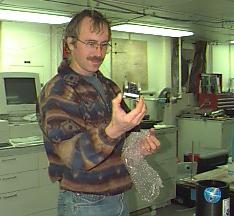
|
Scientist Dave Buterfield examines the part delivered by the Air Force. The component will enable the water sampling instruments to function on the ROV. |
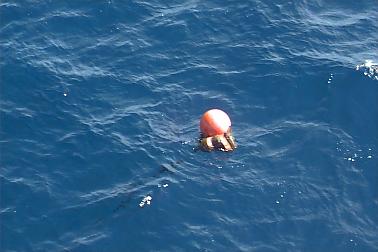 At about 0300 hours this morning ROPOS was back in the water, once again not
carrying the fluid sampler that has remained a problem for the scientists who
are working with it. The computer board that was delivered by the United States
Air Force (McChord Air Force Base, 62nd Airborne's Sonic 11) yesterday is working perfectly, but now there is a problem with one of
the pumps that moves the fluids from the vent into the containers within the
sampler. Scientists are still confident that they can get the pump working
properly and be ready for the next dive.
At about 0300 hours this morning ROPOS was back in the water, once again not
carrying the fluid sampler that has remained a problem for the scientists who
are working with it. The computer board that was delivered by the United States
Air Force (McChord Air Force Base, 62nd Airborne's Sonic 11) yesterday is working perfectly, but now there is a problem with one of
the pumps that moves the fluids from the vent into the containers within the
sampler. Scientists are still confident that they can get the pump working
properly and be ready for the next dive.
In the meantime ROPOS has been involved in retrieving a set of instruments called extensometers. These five signaling devices have been on the sea floor for the past two years. They are designed to measure the rate at which the seafloor is spreading at the Juan de Fuca Ridge. The plan calls for placing the extensometers into a device called the "elevator" that will transport the instruments to the surface. Aboard the R/V Brown scientists will transfer stored data, replace the batteries, and prepare the extensometers for the return trip to the sea floor. For these devices to work properly they must have "line-of-sight" between them. The last time they were deployed problems with the winch system meant that they were simply dropped over the side of the ship. Bill Chadwick, whom you have met in the scientist's page, tells me that they may find little if any useful data from this first experiment. This time, once the batteries are replaced, the extensometers will be placed by ROPOS in positions where we know they will have the required line-of -sight. The instruments operate on standard D-cell batteries (about a meter of them) but they only wake up for about ten minutes each day to communicate with their neighbors, so the batteries last for a couple of years.
Transducers atop each instrument "ping" their neighbors on either side and wait for the responding "ping" to come back. By very accurately measuring the time that this takes the instrument is able to determine if the distance between itself and its neighbors is changing due to movement of the seafloor. The accuracy of the entire string of five extensometers is designed to be within one centimeter of the actual distance. Since the transducers can be moved slightly by currents, there are magnetic compasses and inclinometers included in the electronics package for each instrument. Data from these devices allow the computers to adjust readings back to the zero point for the transducer. Of course the temperature of the surrounding water must be measured since temperature affects the speed of sound through water. When all of these adjustments have been made scientists can determine if and by how much each of the extensometers has moved relative to its neighbors. By such careful, accurate, and repeated measurements are the movements of the ocean floors determined.
Chief scientist, Bob Embley, reports that the ballpark average spreading rate on this portion of the ridge is on the order of 5 cm/yr. The rate is rather "herky-jerky" near the ridge, driven by magma movements within the earth. Well away from the ridge the movement becomes much more consistent since the irregular movement of the ridge is absorbed by the entire plate. Of course at the other plate boundary where this ocean floor dives abruptly under the western edge of North America, things become extremely jerky again. Locked up against the edge of the continents, the plate builds up strain over perhaps hundreds of years before releasing the strain in a major earthquake. Some scientists say the British Columbia, Washington and Oregon could experience as much as an 8.5 or 9.0 earthquake sometime in the next century.
Have you checked your earthquake insurance recently? Have you prepared your emergency survival kit? You can get a free booklet from the Red Cross that will explain preparations you should be making.
ROPOS continues this afternoon to make sonar surveys of the ocean floor. There is nothing to see on the video screens since ROPOS flies about 30 meters above the seafloor for these surveys. We are all going about getting jobs finished and loose items packed away before the weather gets here. Tomorrow may be a short and bouncy report. Stay tuned.
Logbook of all Teacher At Sea postings
Question/Answer of the Day
Send Your Question to NeMO
(oar.pmel.vents.webmaster@noaa.gov)
Back to Calendar